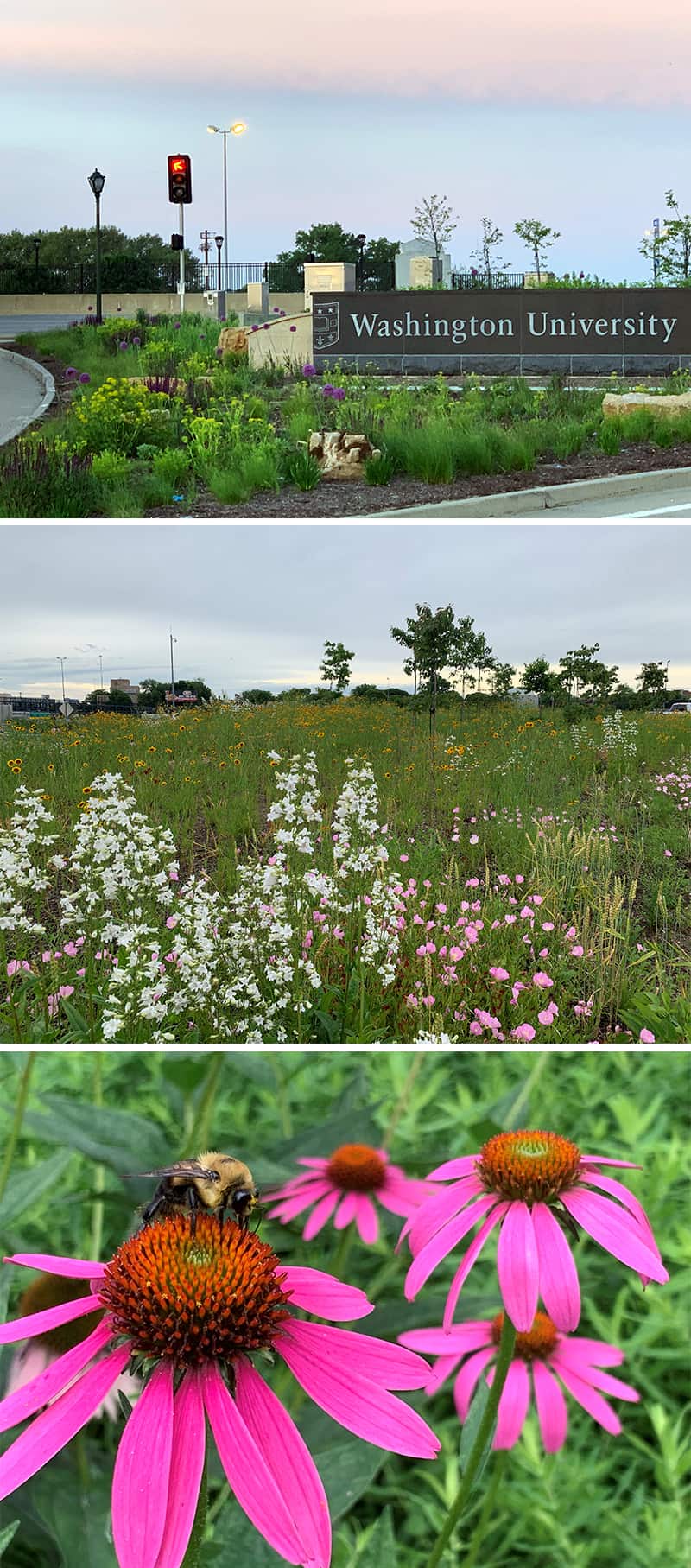CASE STUDY
Situation:

Signage was being updated at what is considered the entrance to Washington University’s Medical School campus at the intersection of Kingshighway Blvd. and Interstate 64. Signage is in large triangular islands surrounded by exit ramps from the highway. The existing landscape at the interchange included 25,000 sq. ft of turf with traditional planting beds of shrub-roses, daylilies, Russian sage, and clusters of holly trees in four traffic islands. The turf required weekly maintenance, and vehicles regularly crossed-over curbs damaging the turf. Repairing damaged turf required additional service. The perennials, roses, and trees were all planted as traditional landscape. The holly trees were in poor condition due to the exposed location and caused interference with site lines in the interchange.
Opportunity:

The installation of new signage presented an opportunity to make dramatic changes to the landscape at the interchange. Focal Pointe worked with Washington University’s Medical Campus partners to develop and implement a plan that was much better suited to the location and the campus core values of health and wellness.
Solution:

All turf was removed, and the entire area was converted to a planting bed. This eliminated the need for weekly maintenance, saving costs, chemical use, and making it safer by reducing the amount of time maintenance crews need to be onsite in a heavy traffic area. Damage from vehicles is more easily repaired with a hard rake and a little mulch, instead of regrading and installing sod.
The planting design had safety/sightlines and ecology at its core. A mix of different plants for yearlong interest in colors, textures, and height. The soil was amended with 100 cubic yards of compost to increase fertility, moisture retention, and increase biologic activity. Lower growing perennials and bulbs were planted to create a mixed community. Eighty-eight percent of the plants selected were native or native cultivars to support ecologic benefits and long-term sustainability of the plant community. To help the community fill in faster a mix of native seeds and winter cover crop was sown to suppress weeds.
For sightline safety, no shrubs were used in the design and only trees that could be limbed-up. The variety of tree selected for the project was the American persimmon. Persimmons are a native tree not commonly used in the landscape. Selected for their adaptability, toughness, and showy bark. The trees were planted in random locations to create a natural grove. As they mature the persimmons will create a natural silhouette against the setting or rising sun as you approach the islands from the east or west.
Weathered limestone boulder outcroppings were added to protect the new signage from wayward traffic. The boulders also add to the natural look of the landscape. The planting looks more like how the landscape might have looked before highways traversed the area than a traditional urban planting.
Obstacles:
Crew safety was the foremost consideration as this project was completed without significant interruption of traffic flow in this very busy interchange. Traffic cones, safety signage and vests were employed, and plant and material deliveries were scheduled during off-peak hours.
Results:

During the initial growing season, the beds performed very well. It was anticipated that there would be a few weeks of no blooms during the first summer, but there was color throughout the growing season. The first spring and summer were wetter than average which resulted in more weeding than expected. During the growing season, the plant community filled in, and some varieties seeded out to regenerate in the gaps. This will help keep weeds down in future years. The plant community will be allowed to regenerate naturally changing as it matures with limited intervention by landscape crews.
The Washington University Office of Sustainability posted an article about the project on their website noting the many benefits of the transition to native plants.
Washington University Medical School Project Manager and Horticulturist, Allan Miller said, “The landscape functions as the front door to the Washington University Medical Campus. The 64/40-Kingshighway’s natural savannah-style design welcomes visitors to the campus and offers a therapeutic and calming arrival experience. These well-designed, well-maintained, and healthy campus entry points, welcome visitors who are often arriving under stressful circumstances.”
Though it is sometimes difficult for people who are used to more traditional landscapes to see the ecological benefits that native plants provide in this type of landscape, Focal Pointe and Washington University have received a great deal of positive feedback for the transformation of this highly visible space. Within a few hours of planting the first island, bees, butterflies, and dragonflies were flying all around as the installation was completed. This more natural approach to landscape is intended to bring calm and tranquility as you enter the campus. Experiencing peace and wellbeing is often a result when we spend time in nature.
